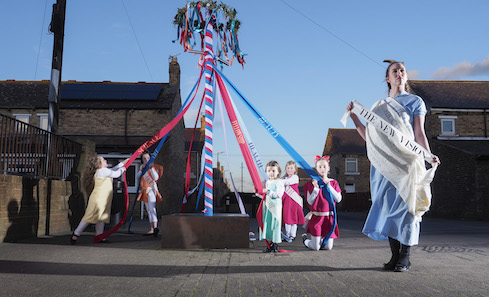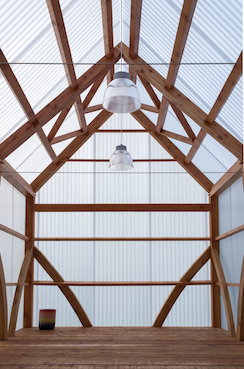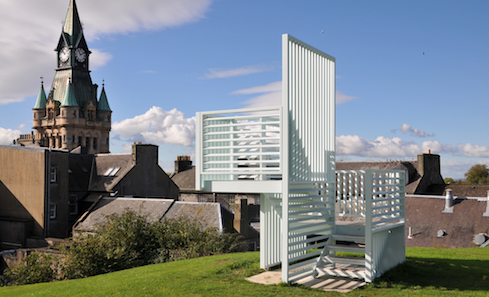Published: 24 May 2017
27 July - 27 August 2017

Walker & Bromwich, A Plea For Common Ownership, 2017. Photo by Mark Pinder
Edinburgh Art Festival (EAF) today announces details of the 2017 Commissions Programme, presenting new publicly-sited works across the city, opening up new spaces for the first time and offering a unique opportunity to experience hidden corners or often overlooked parts of the city.
In Scotland’s Year of History, Heritage and Archaeology, the 2017 commissions programme invites artists to reflect on two important anniversaries for the city – the foundation of the first Edinburgh Festival in 1947, and the publication in 1917 of Patrick Geddes’ The Making of the Future: A Manifesto and a Project. Separated by a generation, both were born directly out of the experience of global conflict, and a strong belief that artists could play a critical role in helping societies to imagine new and better ways of living.
A town planner, conservationist, social activist and polymath, Sir Patrick Geddes was a profoundly visionary thinker whose ideas continue to resonate with contemporary societies around the world. Writing during the First World War, Geddes was acutely aware that out of the destruction of war came an opportunity to build new and better ways of living, and his pamphlet, The Making of the Future, laid out his vision for a society driven not by ‘a machine and money economy’, but ‘a life economy’, advocating a central role for art and culture in helping to build this new society. Thirty years later, the Edinburgh Festival was founded (one of a network of arts festivals, including Venice Biennale and Documenta) with the ambition to ‘provide a platform for the flowering of the human spirit’, seeing art and artists as critical in fostering dialogue across nations in a Europe torn apart by war.
Presenting eight new projects by Scottish and international artists at six sites in and around Edinburgh’s Old Town, The Making of the Future: Now pays homage to the physical and intellectual legacies of Geddes and the festival in the city, making a claim for the continued relevance of their core values and ideas today. For 2017, EAF will open in several new venues, many of which have not previously been open to the public before.
Highlights of EAF’s 2017 Commissions Programme include:

Pig Rock Bothy, part of The Bothy Project, sited at the Scottish National Gallery of Modern Art, designed with Iain MacLeod, photo by Johnny Barrington
Sorcha Carey, Director of Edinburgh Art Festival, said: “In Edinburgh’s 70th anniversary as a festival city, our 2017 commissions look back to sites and ideas of an earlier champion of culture in our city: Sir Patrick Geddes. Geddes famously advised that ‘We need to give everyone the outlook of the artist’ - and in ‘The Making of the Future: a manifesto and a project’ published in 1917, he laid out his vision for a new form of society in which ‘Art and Industry… would henceforth advance in unison’. Profoundly international in his outlook and influence, Geddes’ ideas and thinking laid the foundations for the rich festival culture that has evolved in our city - and our programme of new work by Scottish and international artists, reminds us of his continued relevance in 2017.”
Amanda Catto, Head of Visual Arts, Creative Scotland, said: “This is an ambitious series of commissions that respond thoughtfully and generously to the legacies of the Edinburgh International Festival and Sir Patrick Geddes. Through the eyes of the artists the programme invites us to explore the city from a new perspective, bringing us to spaces and places that we might otherwise overlook. Importantly, the commissions provide an opportunity for people to get engaged with - The Making of the Future: Now - and we are really excited by the possibilities that this presents for everybody that gets involved.”
Paul Bush, OBE, VisitScotland Director of Events, said: “As the UK’s largest annual festival of visual art, EventScotland is delighted to be continuing its support of the Edinburgh Art Festival. The commissions programme is an integral part of the festival and is the perfect stage for celebrating Edinburgh’s two significant anniversaries during Scotland’s Year of History, Heritage and Archaeology. By using the city’s unused built heritage as its canvas, it will showcase the role artists have played in helping heal communities in the aftermath of global conflict.”
Fiona Hyslop, Cabinet Secretary for Culture and External Affairs, said: "The Edinburgh Art Festival is an important and anticipated part of the successful wider festival programme, encouraging everyone in the city to experience and celebrate a diverse range of visual art – especially in Scotland’s Year of History, Heritage and Archaeology.
“As Edinburgh and the Art Festival celebrate the 70th anniversary of the first Edinburgh Festival in 1947, the 2017 programme also marks the 100th anniversary of Patrick Geddes’ The Making of the Future: A Manifesto and a Project. The 2017 programme will inspire creativity, provoke thought and encourage debate, dialogue and discussion, supported by £140,000 from the Scottish Government’s Expo Fund.”
Edinburgh’s Lord Provost, Frank Ross, said: “In this milestone year for the Festival City, I am delighted the Council is supporting the EAF’s innovative and creative Commissions Programme. Celebrating the city and the people of Edinburgh, I look forward to welcoming artists from all over Scotland and the world to take part.
“As one of the nation’s pioneering town planners and botanists, Patrick Geddes shaped places in Edinburgh we still enjoy every day. From the Zoo to Camera Obscura, it is particularly fitting his work will be celebrated with a rare opening of another of his designs which was later to become his home - Ramsay Gardens.”

Tower, Dunfermline, Toby Paterson 2014. Photo by Toby Paterson
Founder of The Bothy Project, Edinburgh-based Bobby Niven will present a new site-specific social sculpture entitled Palm House/ Artists' Workshop within Johnston Terrace Wildlife Garden. Founded in 2011, Niven’s ongoing Bothy Project is an experiment into the creative benefits of spending time off-grid, working with architects, designers and artists to design and build a network of creative residency spaces. For EAF 2017, Niven will create a temporary studio workshop within the Johnston Terrace Wildlife Garden - an urban wildlife reserve first established as a community garden by Geddes in the late 19th century, as one of a series of green spaces developed by Geddes to provide much needed space and light for some of the city’s poorest citizens. The structure - inspired by the ideas of Geddes and by the history of the Palm Houses of Edinburgh's Botanic Gardens - will combine a timber frame architectural form, hand-carved anthropomorphic sculptural elements, and transparent cladding of walls and roof. Fulfilling its social purpose, the structure will be a space for growing and working - for sharing and exchanging conversation, plants, cooking, food and other activities that collectively invite exploration of the particular context and value of this oasis of urban wildlife.
The space will host a programme of artists' residencies, and a series of environmentally focused workshops for families, including a weekly Forest School for young children. Artists Neil Bickerton, Daisy LaFarge, Deirdre Nelson and Alison Scott will take up residency in the space for a period one week over the duration of the festival.
This summer, a giant dragon sculpture will take over the remains of the 16th century church, Trinity Apse, as the focus of a series of playful performative rituals and a public pageant. The Dragon of Profit and Private Ownership by Glasgow-based artist duo Walker and Bromwich, known for their ambitious large-scale sculptural works and participatory events, invite audiences to consider an alternative way of living by re-igniting Utopian ideologies through the use of protest, pageant, celebration and contemplation. Inspired by Geddes’ social activism, the artists explore ‘the space between what exists and what is possible’, using their work to open up a space where the possible and the actual unite. Reflecting on a range of radical thinkers from the turn of the 19th/ 20th century who strove to create the conditions for a fairer society, Walker and Bromwich will consider these utopian visions in the context of today's fractured political climate. The artists are also working with the children and families of Canal View Primary School, Wester Hailes – bringing the outskirts of Edinburgh back to the centre while examining alternative models of capitalism inspired by one of Geddes' phrases 'By Leaves we Live ... not by Coins’.
Working predominantly within performative and video based practices, New Zealand-based artist Shannon Te Ao will create a new video installation. Juxtaposing footage shot in different locations throughout the former British colony of Aotearoa New Zealand, the physical, social and poetic recur through a multimedia installation. Featuring references to: a 1840s Māori song; a dance scene from a 1970s Charles Burnett film; a hemp farm; a 1960s Clyde Otis song famously sung by Dinah Washington; Te Ao will present a nuanced installation exploring the physical and emotional depths of love, grief, sickness and the complications of healing. The artist’s holistic approach to the body in the landscape, and his interest in the political discourses which landscapes can host, offer a contemporary and profoundly poetic response to Geddes’ vision of society based not on ‘money and machines’ but a ‘life economy’.
Glasgow-based Toby Paterson, an artist with a strong interest in the built environment, will create The Sociology of Autumn as part of EAF’s 2017 Commissions Programme. Through an intervention into the site of Chessels Court, Paterson will create a new work for this tranquil public courtyard, comprised of interrelated sculptural, architectural and landscape elements that work with – and respond to – the essential colours, materials and form of Edinburgh's Old Town. Long fascinated by the widespread influence of Geddes' empirical studies of cities, undertaken as a means to study human activity and society, Paterson’s work reveals a deep interest in modern architecture and the new public spaces that emerged in Britain in the post war years. The work will create a landscape that invites reflection on Geddes' observations on the city and how it is experienced, set in the context of Chessels Court and the High Street today.
A Summer Meeting (11-14 August) will take place as part of EAF’s Events Programme, presenting a weekend of events focused on the central ideas proposed by Geddes and the relevance of these today, including a workshop devised in partnership with North Edinburgh Arts, in Muirhouse, and a specially curated event taking place in the original home of Geddes in Ramsay Gardens. The weekend will also feature artists’ talks, and tours and a Walker and Bromwich event entitled How do we slay The Dragon of Profit and Private Ownership?.
Approaching its third edition, EAF is pleased to announce details of Platform: 2017, the Festival’s dedicated initiative to support emerging artists at the beginning of their careers. Annually, Platform exhibits new work by four recently graduated artists, allowing them a platform to present work alongside internationally-renowned names. This year, artists Graham Fagen and Jacqueline Donachie have selected four artists from an open call; the 2017 edition will show new work by Uist Corrigan (DCJAD graduate, based Lumsden); Adam Quinn (GSA graduate, based Glasgow), Rebecca Howard (ECA graduate, based Glasgow), and Kotryna Kiliulyte (GSA graduate, based Glasgow). This group exhibition, on show for the duration of the festival, will be held at The Fire Station, Lauriston Place, a Victorian Fire Station, run as the Fire Museum in recent years, and recently acquired by University of Edinburgh for the expansion of Edinburgh College of Art.
For media enquiries, please contact: Flora Macfarlane, SUTTON: Flora@suttonpr.com | +44 (0) 20 7183 3577
Founded in 2004, Edinburgh Art Festival is the UK’s largest annual festival of visual art, bringing together the capital’s leading galleries, museums and artist-run spaces, alongside new public art commissions and an innovative programme of special events in a city-wide celebration of the very best in visual arts. The 2016 festival attracted just over 308,000 attendances, including a 7% increase in visits to partner exhibitions. Edinburgh Art Festival is a charitable organization supported by Creative Scotland and the City of Edinburgh Council. For more information, please visit www.edinburghartfestival.com or follow on Twitter at @EdArtFest
2017 Year of History, Heritage and Archaeology
The Scottish Government Edinburgh Festivals Expo Fund recognises the exceptional creative talent that exists in Scotland and gives it an international platform on which to excel. It is available to all 12 festivals to support the development of Scottish-based work. The Scottish Government is proud to support the festival via the Expo Fund and have provided £140,000 this year to bring innovative work from artists in Scotland and internationally to new audiences and venues.
Creative Scotland is the public body that supports the arts, screen and creative industries across all parts of Scotland on behalf of everyone who lives, works or visits here. Creative Scotland enables people and organisations to work in and experience the arts, screen and creative industries in Scotland by helping others to develop great ideas and bring them to life. Creative Scotland distributes funding provided by the Scottish Government and the National Lottery. For further information about Creative
Scotland please visit: www.creativescotland.com www.facebook.com/CreativeScotland @creativescots
The City of Edinburgh Council is a funding partner for Edinburgh Art Festival. The Council accommodates the organisation at City Art Centre and provides regular use of Trinity Apse and other Council-owned property for festival activities. The Council aims to maintain and build on Edinburgh's reputation as the ideal location for major events and festivals. Working with the city’s cultural sector, the Council’s arts development team ensures that arts play a vital and lasting role in Edinburgh by developing strategic policy, offering advice on cultural projects and awarding cultural grants.
EventScotland is working to make Scotland the perfect stage for events. By developing an exciting portfolio of sporting and cultural events EventScotland is helping to raise Scotland’s international profile and boost the economy by attracting more visitors. For further information about EventScotland, its funding programmes and latest event news visit www.EventScotland.org. Follow EventScotland on Twitter @EventScotNews.
EventScotland is a team within VisitScotland’s Events Directorate, the national tourism organisation which markets Scotland as a tourism destination across the world, gives support to the tourism industry and brings sustainable tourism growth to Scotland. For more information about VisitScotland see www.visitscotland.org or for consumer information on Scotland as a visitor destination see www.visitscotland.com.
British Council Scotland's mission is to build long-term international relationships and trust between the people of Scotland and other countries through the exchange of ideas, knowledge and information in the arts and education. British Council’s involvement in the arts arena stretches back to 1947 when we helped to found the Edinburgh International Festival and every year we continue to work on new and exciting cultural projects connecting Scotland and the world. For further information please visit scotland.britishcouncil.org or follow on Twitter @BCScotland
Investment managers Baillie Gifford are Project Sponsors for the installation of Bobby Niven’s new commission. Over the past three years, Baillie Gifford have played a role in enabling EAF to reimagine overlooked parts of the city through its commissions programme, supporting Callum Innes to create his first light-based work, The Regent Bridge, now permanently installed in a formerly dark tunnel on Regent Road; and funding the restoration of the burnt-out watchtower in New Calton Burial Ground for Christine Borland and Brody Condon's 2013 commission Daughters of Decayed Tradesmen.
Edinburgh World Heritage (EWH) is a charity with the role of conserving, enhancing and promoting the city’s World Heritage Site. EWH administers a Conservation Funding Programme, with funding provided by Historic Scotland, which acts as a catalyst encouraging others to invest in the city’s built heritage. Last year £179,384 was awarded through the programme, which attracted a further £792,179 of expenditure on the city’s historic buildings and streets. In other words, for every £1 EWH receives from the public, a further £5 is leveraged from other sources.
The New Waverley Community Fund is a joint project between the City of Edinburgh Council and the developers of the New Waverley site in Edinburgh’s Old Town.
Creative New Zealand is the New Zealand’s arts development agency encouraging, promoting and supporting the arts in New Zealand though funding, capability building, an international programme and advocacy.
Te Tuhi is one of New Zealand’s foremost contemporary art spaces and a leader in supporting experimental practice. Te Tuhi is committed to contemporary art that is locally engaged, regionally responsive and internationally ambitious. Te Tuhi’s primary focus is on research and commissioning ambitious new works, acting as a catalyst for new ways of thinking and engaging with communities. Te Tuhi has a growing international reputation for its innovative programme, one characterised by risk-taking with a strong awareness of social, political and environmental issues. Te Tuhi has a long history of working with nationally and internationally established artists such as Aernout Mik, Tom Nicholson, William Pope.L, Santiago Sierra, The Otolith Group, Tehching Hsieh, Artur Zmijewski, L. Budd, Phil Dadson, Julian Dashper, Darryn George, Maddie Leach, Alex Monteith, Kate Newby, Luke Willis Thompson, and Kalisolaite 'Uhila. tetuhi.org.nz